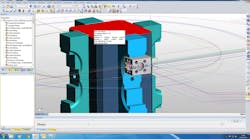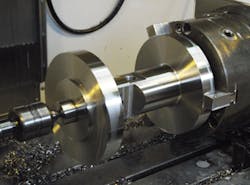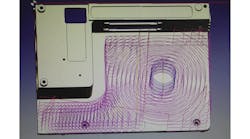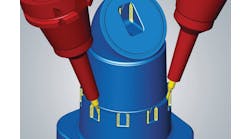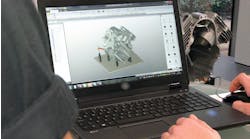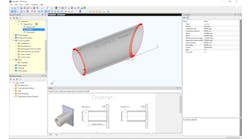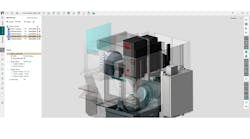In Norwich, England, a precision engineering subcontractor serving uses a combination of novel workholding and Edgecam software to protect its margins, as customers demand price cuts, and material and consumable costs rise. Milltech Precision Engineering Ltd.’s manufactures high-value components in low volumes, for medical, aerospace, nuclear/oil/gas, marine, mechanical handling, packaging, automotive and motor sport customers.
According to operations director Darren Osborne, absolute precision is vitally important to the shop’s work. “Without precision we don’t have a business – and Edgecam gives us that precision,” he said.
Edgecam is a CAM program developed by the Vero Software Group that combines sophisticated toolpath generation with seamless CAD integration, thereby offering a complete solution for milling, turning and mill-turn programming.
The components that Milltech produces are used as connectors for robot arms that inspect the inside of nuclear cores; or, for oil-and-gas subsea equipment, for down-hole drilling and wellhead control. Other applications include suspension assemblies, braking systems, and prototypes for the development of fuel efficiency and emission controls for the automotive industry; packaging equipment; camera parts, along with stainless steel ventilator tubes and CT housings for the medical industry; and rear wing parts for Formula 1 cars.
Mike Ottolangui, managing director of Milltech, which has an estimated $5.5-million turnover, with 38 employees, said the greatest threat to his firm’s growth has been the nationwide shortage of skilled craftsmen. But, since installing Edgecam last year (on the advice of a customer that is long-standing Edgecam user), just one manufacturing engineer, Daniel Clements, handles all the programming that would have required eight people to complete previously.
Edgecam drives Milltech’s 21 Haas machining centers, including two 4-axis horizontal mills, and plans are well advanced to bring it in for their 18 lathes.
Horizontal Access
As well as proving crucial to their development, their innovation in customizing Edgecam – particularly with regard to the unique way they work with the horizontal mills – also contributed to the shop’s successful placement in the U.K.’s Engineering Employers' Federation’sSouth East Business Growth Award, and being runners-up for the EEF’s national competition.
“We thought our way of working with horizontals was common to the industry because it’s so efficient,” said Mike Ottolangui. “But, we discovered that no one else was doing it the way we are.”
The complexity of Milltech’s specific requirements meant it took Edgecam developers around five months to finalize their post-processor.
“Traditionally horizontals are aimed at the medium- to high-volume industry, but the way our post-processor were specially written, and how we’ve modeled our fixtures and workholding, means we effectively use those machines for one-offs and very small batch sizes,” Darren Osborne explained, offering a shop-floor perspective. “Thanks to our post-processor it’s now easier to set the horizontals than the verticals.”
Having designed its own workholding system, Milltech now produces a program for one component, and then answers dialog prompts from the post-processor. For example, ‘how many components do you want to run on a tombstone?’; or, ‘how many datums do you want to use?’; and, ‘how many faces on that tombstone do you want to run?’ Then datums and programs are automatically generated for the other components. “It means we can run up to 32 components on four faces of a tombstone, but we actually only produce a program for one component,” Osborne said.
The Edgecam Process
“When we receive a solid model from the customer we look at each element on the drawing in Edgecam Part Modeler to verify its accuracy, making sure it ties in with the orthographic drawing,” according to Darren Osborne.
“As we’re using associative machining we may alter the model as well, particularly on bores, to make sure we’re hitting mid tolerances,” he continued. “This is because some designers will come in on the low end and others on the high end, and we want to hit mid tolerance on all the features.” Using the tool store database, Milltech programmers identify the technology in terms of the materials being used. “I spent our first six months of having Edgecam concentrating on the tool store, looking at the consumable tools we use and populating the tool store with manufacturers’ recommended feeds and speeds.”
After that, they decide whether the component is best suited for a vertical or horizontal mill, because that does affect the method of programming. Once the program is produced they run it through Edgecam’s powerful simulator to ensure the component is machinable with no crashes.
“We save the PPF file on the server and post the program to the relevant machine,” Osborne detailed. “It’s populated with any specific instructions including set-up, and the program field may also feature a video of the simulation so the operator can see exactly what’s happening, before setting the relevant datums and producing the component.”
The last word on Edgecam comes from Mike Ottolangui: “Our customers are demanding price reductions because of the world economy: material prices are increasing, and consumable tooling costs are going up. Therefore, we need to be smarter, and do things quicker and more effectively. Edgecam is the major player in protecting our margins. Looking back on one or two of our important strategic decisions, we can see that our Tricorn ERP system and Edgecam are the two significant factors in Milltech’s success.”
